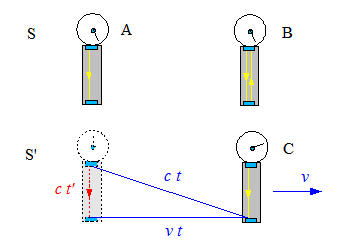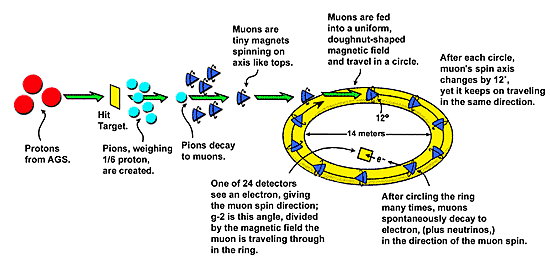The Consequences Of Special Relativity
In my last post I mentioned the two postulates Einstein formulated in 1905:
- The Principle of Relativity: The laws in nature are the same in all inertial reference frames.
- The Constance of Light: In all inertial systems is the speed of light in a vacuum the same for all observers.
These postulates result in consequences for our daily life and they have mostly been proven true via experiments. In this post I will mention these consequences and also explain how they have been proven to be true.
The speed of light as maximum
The first consequence is that nothing can be faster than the speed of light.
In the Galilean transformation only an infinitely high speed is able to be constant in every inertial system. Since light has this unique “ability” in Einstein's postulates, we can conclude that the speed of light is the fastest possible speed reachable.
The Galilean transformation is a fundamental understanding for classical physics. It describes transformations between two inertial systems. This transformation only applies to small speeds, and if we deal with EMRs we have to work with the Lorentz transformation.
The time dilation
Every moving clock slows down relative to observer. This means if we move, time slows down. And we can calculate the difference.
t' = t*√1-v²/c²
To understand this principle we have to imagine a astronaut. So our astronaut Neil has a twin brother. His twin brother Michael waits about 20 years for Neil’s return. Neil flew with 99% of the speed of light. When Neil is back on Earth he has not aged as much as Michael and this is due time dilation. How much younger is Neil now compared to Michael? This is something we can calculate with the formula above.
t' = 20 years * √1-0.99c²/c² = 2.82years
Neil is now 17 years and 2 months younger than Michael because time slowed down for Neil.
How is this possible and is there any proof?
There are, in fact, experiments which prove that time dilation occurs. One of these experiments is the muon experiment, but first we have to derive the formula and understand its concept.
To understand the concept we have to define what a moving and standing clock is. Since we know that inertial systems are either moving or standing in respect to someone. If we stand on the moon we see the Earth move around the sun, but the Earth is standing in respect to the inertial system (human-earth).
In a nutshell every clock is moving so we have to set a fixed clock. In our astronaut example the fixed clock was the time on earth and the moving clock was the time in the rocket.
Imagine three clocks. Clock A and B is fixed while clock C is moving. All clocks start ticking then C reaches clock A and they stop ticking then C reaches B. Imagine a flying clock which moves from A to B.

So while light goes 2 times through the clocks A and B it only travels one time through C. This is because C is changing its inertial system, while A and B are fixed.
With this in mind we can derive the equation. For doing so we use the pythagoras sentence.
(t (t')c)² + (tv)² = (tc)²
if we solve this one after t² we get
t²= (tc)²-(tv)²
and if we now take the root, we receive our formula.
Of course there are other ways to derive the equation.
I found a really nice way on this site
When we look closely at the equation we realize that the higher the speed, the higher the time dilation, but we can never reach the speed of light. We also have to keep in mind the higher the speed, the higher the mass. Before I explain this phenomena, I want to explain the muon experiment and the length contraction.

The muon experiment
Muons are charged leptons (elementary particles with ½ spin). You do not have to understand exactly what these muons are in order to understand the experiment. Imagine electrons which have a half life time of 1.52 microseconds (10^-6 seconds). This means if you have 100 million muons in the beginning, you will have only 50 million left after 1.52 microseconds.
We can create these muons in CERN (European research organization that operates the largest particle physics laboratory in the world) and then we can put them in a magnetic field. If muons decay they create electrons, which we can capture in this magnetic field and record the time they took to decay.

Muons travel with a speed of about 0.9994c and now you can guess what happens - instead of decaying after 1.52 microseconds they decay after 43.9 microseconds. This makes sense if we use our formula.
t'=43.9 microseconds*√ 1-(0.9994c)²/c²= 1.52 microseconds
Normally you would calculate with SI (International System of Units), in this case it would be seconds instead of microseconds, but we can ignore it for our calculation.
The length contraction
The time dilation explains the muon or astronaut phenomena only in our perspective when we are on earth. How is it understandable for the muons or humans traveling that fast?
Basically the way to calculate is the same, but instead of thinking of time, we think about a changing in the length of distance travelled. So we use the same formula, but instead of calculating the time we calculate the length. The faster you move, the shorter the route.
l'=l*√1-v²c²
Relativistic mass
A body has a rest mass and this mass changes when the body is in motion. The faster the body, the higher is the mass.
m (rest mass) = m' *√ 1-v²c²
This is also one of the reasons why we struggle to reach a high velocity.
Conclusion
This is it the last part about special relativity. I hope you enjoyed it and learnt a bit about these concepts.
Of course, this is not all. I could also try to explain Minkowski diagrams, the Lorentz transformation and the Doppler effect, but for now I think this is enough. Inn future I will publish other special relativity posts again. Because there is so much to write about. I will also try to keep these posts updated when new conclusions are made in science.
The next topic will be electric/electrodynamics. I do not know how many parts this topic will have, but we will see. I hope the quality of my posts will be better and I get to improve my editing skills.
As always, feel free to correct me. I hope you enjoyed reading. Feedback in the comments would be great.
Hi please visit @steemstem account. I think you will find some useful info:
https://steemit.com/steemstem/@steemstem/being-a-member-of-the-steemstem-community
Thank you and really cool! I am also a supporter of more science in Steemit
Here you go mate :) A comment and a few upvotes!
Keep up the great work and be prepared for a few setbacks... power through and you'll do well :)
thx
Markdown guide
Congratulations @h0g.mercury! You received a personal award!
Click here to view your Board of Honor
Congratulations @h0g.mercury! You received a personal award!
You can view your badges on your Steem Board and compare to others on the Steem Ranking
Vote for @Steemitboard as a witness to get one more award and increased upvotes!